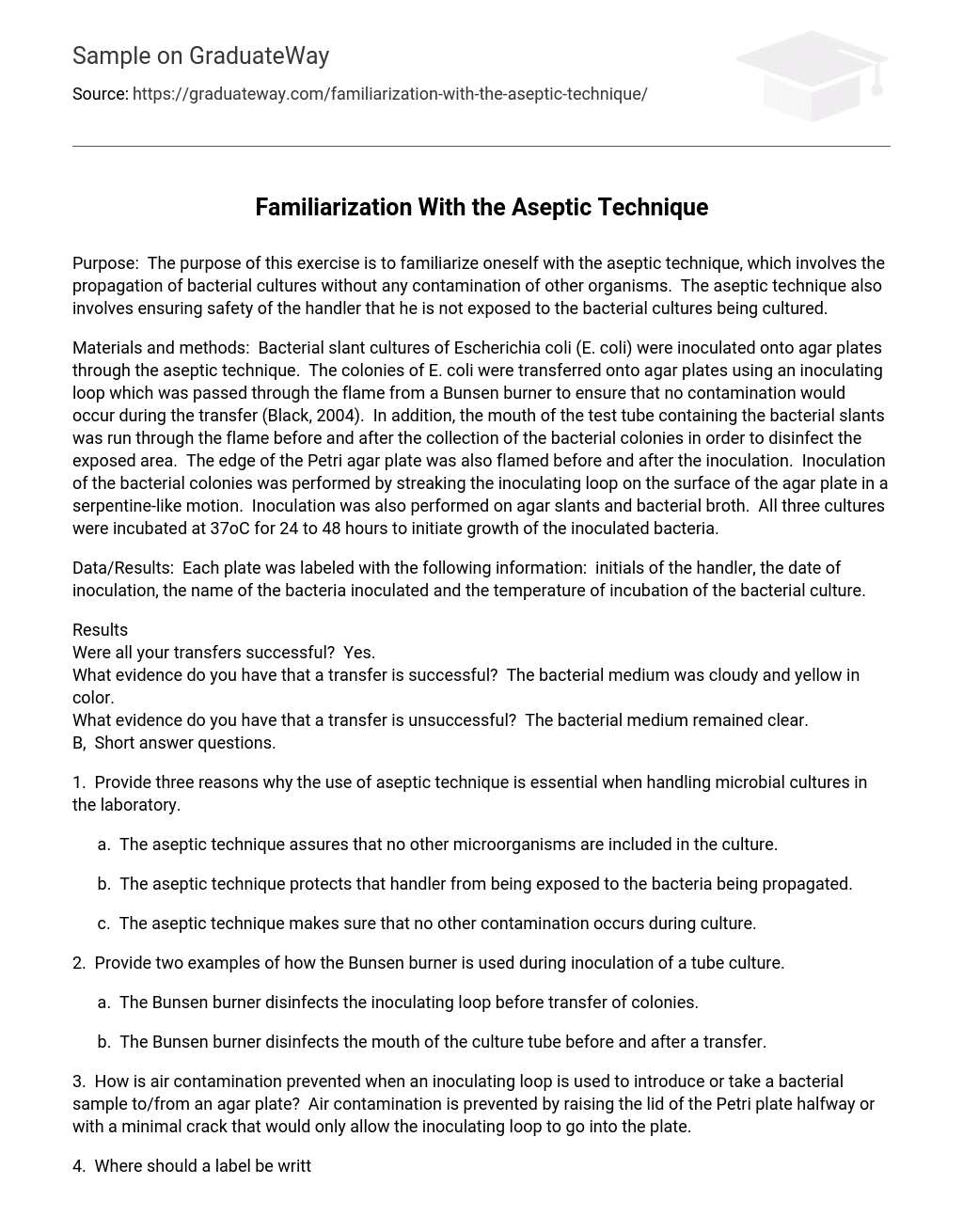Purpose: The purpose of this exercise is to familiarize oneself with the aseptic technique, which involves the propagation of bacterial cultures without any contamination of other organisms. The aseptic technique also involves ensuring safety of the handler that he is not exposed to the bacterial cultures being cultured.
Materials and methods: Bacterial slant cultures of Escherichia coli (E. coli) were inoculated onto agar plates through the aseptic technique. The colonies of E. coli were transferred onto agar plates using an inoculating loop which was passed through the flame from a Bunsen burner to ensure that no contamination would occur during the transfer (Black, 2004). In addition, the mouth of the test tube containing the bacterial slants was run through the flame before and after the collection of the bacterial colonies in order to disinfect the exposed area. The edge of the Petri agar plate was also flamed before and after the inoculation. Inoculation of the bacterial colonies was performed by streaking the inoculating loop on the surface of the agar plate in a serpentine-like motion. Inoculation was also performed on agar slants and bacterial broth. All three cultures were incubated at 37oC for 24 to 48 hours to initiate growth of the inoculated bacteria.
Data/Results: Each plate was labeled with the following information: initials of the handler, the date of inoculation, the name of the bacteria inoculated and the temperature of incubation of the bacterial culture.
Results
Were all your transfers successful? Yes.
What evidence do you have that a transfer is successful? The bacterial medium was cloudy and yellow in color.
What evidence do you have that a transfer is unsuccessful? The bacterial medium remained clear.
B, Short answer questions.
1. Provide three reasons why the use of aseptic technique is essential when handling microbial cultures in the laboratory.
a. The aseptic technique assures that no other microorganisms are included in the culture.
b. The aseptic technique protects that handler from being exposed to the bacteria being propagated.
c. The aseptic technique makes sure that no other contamination occurs during culture.
2. Provide two examples of how the Bunsen burner is used during inoculation of a tube culture.
a. The Bunsen burner disinfects the inoculating loop before transfer of colonies.
b. The Bunsen burner disinfects the mouth of the culture tube before and after a transfer.
3. How is air contamination prevented when an inoculating loop is used to introduce or take a bacterial sample to/from an agar plate? Air contamination is prevented by raising the lid of the Petri plate halfway or with a minimal crack that would only allow the inoculating loop to go into the plate.
4. Where should a label be written on an agar plate? The label should be written on the bottom of an agar plate.
5. How should agar plates be incubated? Why? Agar plates should be incubated at 37oC because this is the optimal temperature that would promote growth of bacteria.
6. Against which organisms are disinfectants effective? Against which type of organism may they not be effective? What disinfectant(s) is used in your laboratory? Disinfectants are effective against vegetative cells. The disinfectants are not effective on endospores and yeasts. Bleach was employed as disinfectant in the laboratory.
Multiple choice questions.
A disinfectant is used on your work surface:
e. All the above are correct.
To retrieve a sample from a culture tube with an inoculating loop, the cap of the tube is:
b. removed and held with the fingers of the loop hand.
An inoculating loop or needle is sterilized in a flame:
c. until it is entirely bright red.
Summary/Conclusion: The aseptic technique is an essential procedure in microbiological exercises because it prevents unwanted contamination of the bacterial cultures, prevents contamination of other microorganisms and protects the handler from being exposed to the bacteria.
Reference
Black JG (2004): Microbiology: Principles and explorations, 6th ed. New York: Wiley. 920 pages.





